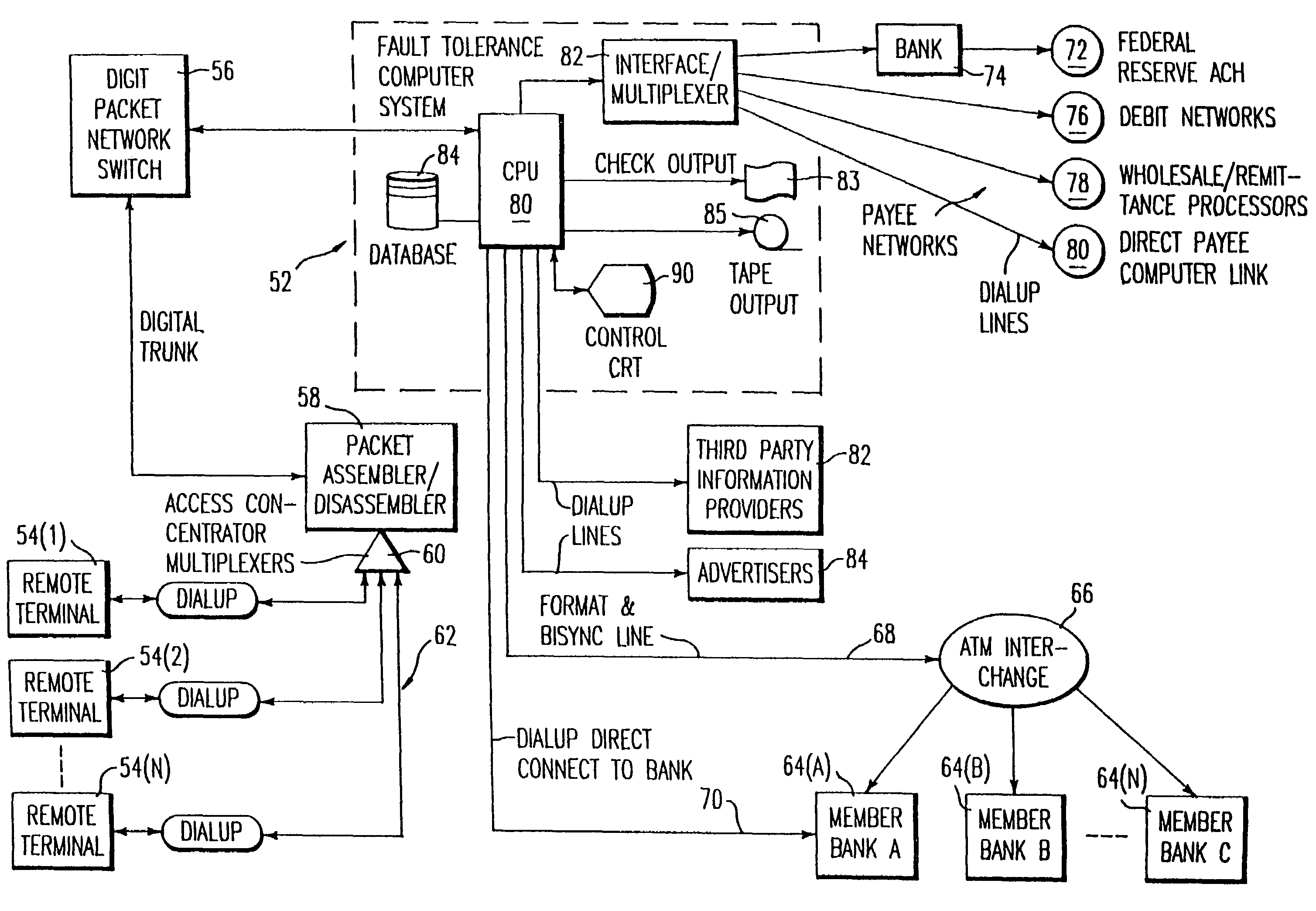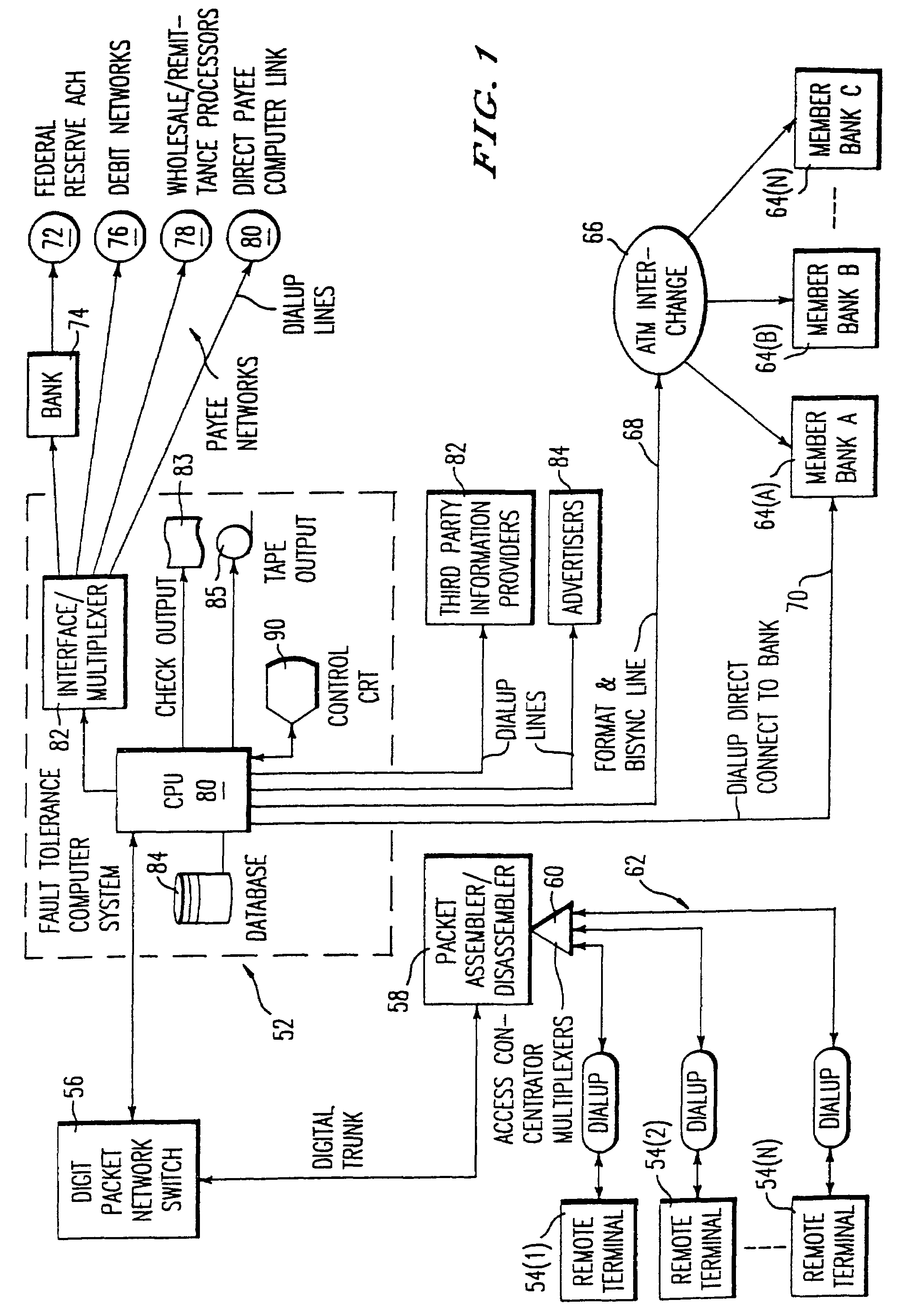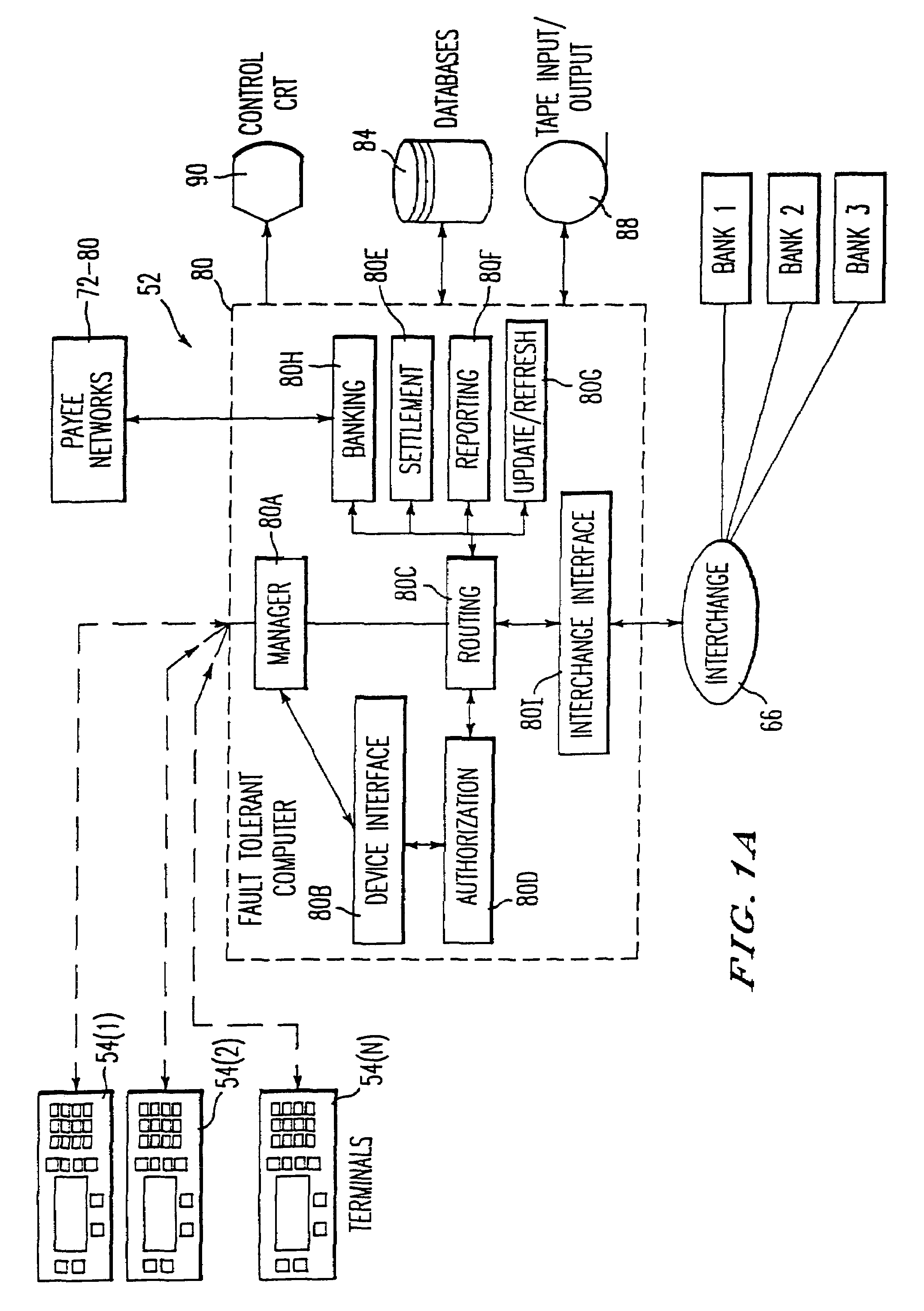Even computer literates who own home personal computers find use of the computer to be relatively limited.
As one example, it continues to be relatively expensive and impractical to send “mail” electronically.
Telecommunicating over telephone lines is relatively expensive, and only just recently have regional telephone companies entered the
public data network (PDN) business thereby increasing capacity and reducing user costs.
Moreover, most intended electronical mail recipients do not even have computers, the necessary communications equipment and the knowledge and experience.
Perhaps more importantly, the “
learning curve” associated with familiarizing oneself with new
software is often so steep that even computer literate people look upon learning a new
software package with great disdain and apprehension.
In addition, the cost of providing home banking services have been enormous.
Service providers incur very high communications costs in linking their central processors with PC users, banks, and payees (merchants).
Many payees also do not accept electronic payments (for lack of substantial volume), forcing service providers to make costly paper-based payments.
These and other costs have been passed along to consumers, thereby dampening the demand for home banking services.
In part because of the problems discussed above, PC-based home banking is not yet a practical reality for most consumers.
In fact, many home banking programs launched in the past have been declared failures and discontinued.
Few corporations continue to market cumbersome, hard-to-use, PC and modem-based home banking systems developed a few years ago.
Nonetheless, telephone billpaying has serious limitations because of its lack of a
visual interface (i.e., display).
Telephone voice response systems only permit the presentation of very limited, simple alternatives.
Sophisticated service offerings are not practical because of their reliance on complex branching alternatives which can not be easily remembered by users.
As a consequence, telephone billpaying users easily lose track of their place; confirmation and review of payments is limited; users need to keep track of payee code numbers on separate paper lists; and user options such as scheduling payments become exceedingly complex and thus virtually impractical.
Telephone billpaying service providers have high cost structures and, despite advances in voice-response technology, telephone billpaying has serious inherent service limitations.
Telephone banking is convenient but has inherent limitations which make billpaying and other complex financial services very hard-to-use.
ATMs, on the other hand, are very easy-to-use, but lack the convenience of a telephone.
Moreover, most ATMs generally do not permit customers to pay bills or conduct other complex financial transactions—typically limiting the user to withdrawals, account inquiries, account transfers, and, if the ATM the user accesses is that of his own bank, deposits.
Unfortunately, the prior art discussed above does not provide any practical architecture for providing comprehensive banking services (including paying plural bills to user selected payees) in the home or office over standard dialup telephone lines via an ATM network.
Home banking was thereby confined to the extremely small niche of sophisticated PC users.
However, the data packet price of local PDN services is usually lower for regional telephone companies (because the cost of their networks is amortized over many users and alternative uses.)
1) Keyboard and Screens: The latest ATM machines contain simple uncluttered keyboards usually consisting of an alpha /
numeric keypad, a cancel key, enter key and a number of “soft” (i.e., programmable) selection keys adjacent to the screen which have no
fixed function. The function of these soft keys is described on the screen and is related to service that is being provided. Older machines tend to have multiple dedicated function keys that perform one
specific function. The user must push the
proper function keys in the correct sequence to complete the transaction in which he is interested. These keyboards tend to be cluttered and confusing. The displays associated with this type of keyboard are usually limited to several lines of text. The dedicated key
keyboard design approach is necessary because the limited size of the display precludes the presentation of multiple alternatives among which a user may select. Newer machines have larger video displays consisting of from four to eight lines and “soft” keys that fulfill different functions depending on information provided on the screen. Users are presented with multiple choices and asked to select the desired alternative. The user pushes the “soft” key that corresponds to the selection he wishes to make. Similar to the newer ATM machines, the terminal provided by the present invention contains a four line by, for example, 24-character LCD display (many ATMs use video displays), four “soft” keys, a cancel and a
numeric keypad. In addition, the terminal provided by the present invention contains a HELP key and two screen control keys labeled PRIOR and NEXT. Unlike ATM machines a user who needs assistance can obtain it regardless of “where he is” in the transaction process by pushing the HELP key. Contact sensitive help provides explanations regarding the transaction in which he is involved. The screen control keys permit the user to scroll forward and backward when reviewing lists. Using the NEXT key also permits movement from one screen to the next at the user's pace. The CANCEL key permits the user to correct erroneous input or back out of certain transactions when he has mistakenly chosen an alternative.
2) Security: The ATM establishes a user's identity by requiring a card and the use of a
personal identification number (PIN). The terminal provided by the present invention uses a slightly different approach in that no card is required (although in at least one configuration a card may be used if desired). The terminal is generally in a more secure location than is an ATM
machine. At SIGNON the terminal transmits a unique number that identifies a particular household. The individual selects his name from the authorized household
list. He is then requested to enter his PIN in much the same manner as with an ATM
machine. The data transmitted from the terminal is encrypted, providing security against line tapping or theft of the line. An ATM uses a bank card to determine who is signing on the
machine; in contrast, in accordance with one aspect of the present invention, terminal possession is used as an indication of one of several users in a household.
3)
Look and Feel: The newer ATM machines are menu driven, the user is presented with a number of alternatives and he selects the one he wishes by using “soft” keys. This is preferable to the user having to follow a
list of steps coordinating screen instructions with different dedicated function keys on a nearby keyboard. There is less
distraction and
confusion when the user is provided alternatives on the screen. He can be given assistance upon request when he is uncertain. There is no limited reading of keycaps or coordination of key colors or reading of sequential instruction lists posted on the machine. In a similar fashion the terminal provided by the present invention is menu oriented. The user can get to his desired service quickly (generally with selections from 1-2 levels of menus). The combination of “soft” keys and menu branching provides a
look and feel very similar to an ATM with which he is comfortable and experienced although the terminal provided by the present invention also provides several additional important features which provide increased functionality.
4) Services: The ATM primarily provides balance inquiry, cash withdrawal and check deposit accompanied by a
receipt. Some ATMs permit limited bill
payment and last date of deposit and withdrawal. Instead of printing out a
receipt like an ATM, user of the terminal provided by the present invention receives a statement from his bank at the end of the month. In addition, it is unlike an ATM in that you generally cannot receive money or make deposits through the terminal (unless an additional interface to a
debit card or “
smart card” is provided). The terminal user is, however, able to pay all bills (present and future or pay periodically), transfer funds (today and in future), obtain balance information, look forward and backward at statement activity (payments, deposits and transfers) transfer funds among accounts and banks, obtain information on bank services and rates anywhere there is a standard telephone RJ-11 jack. With the addition of an alpha keyboard (which may be an expansion feature) the terminal can provide E-mail and other alpha-dominated services.
5)
Personal Service: The terminal provided by the preferred embodiment of the present invention is compact and portable and is available for use twenty-four hours a day. The
list of payees the user selects can be anyone, not a preselected list as with the few cases where users pay bills from an ATM. The services are available when the user wants, where the user wants. His billpaying time is reduced and he need not contend with stamps, check printing fees, envelopes, and postal delivery.
6)
Network Configuration: The ATM machine is usually connected to a bank's computer via telephone or hard line. Accounting information is provided by the bank's computer. Transactions that must be passed to other banks are transmitted through the ATM network. Those ATMs that permit billpaying inventory the bills that are to be paid during the day at the ATM machine and are then posted after the close of the banking day by the bank. The ORL
system passes bill payments directly through the ATM interchange (in the form of point-of-sale transactions) for debit and credit of accounts on a real-time basis.
Secondly, payees may hold remittance accounts at banks who are members of the ATM network.
The cost of
processing payments is relatively low in terms of equipment and communication costs.
Targeted (but low readership) direct mail costs advertisers $0.45-$1.00 per piece.
A major obstacle in building any volume-oriented business is the upfront investment required to reach a critical
mass of customers.
Bank owned ATM networks generate volume and earn fees.
 Login to View More
Login to View More  Login to View More
Login to View More 


